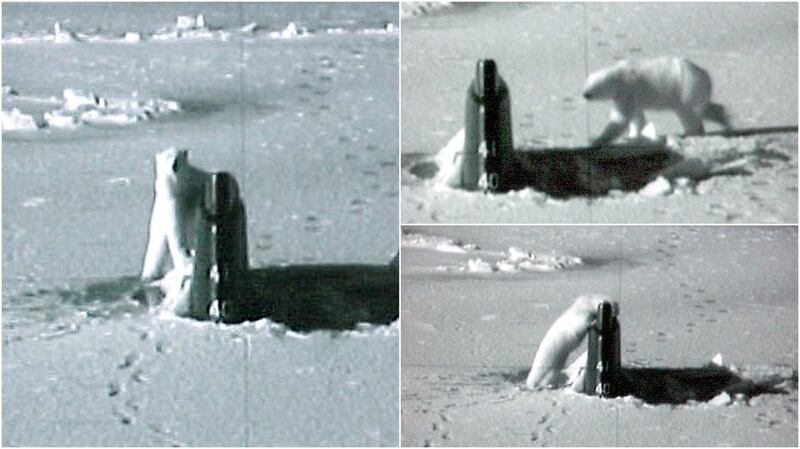A U.S. nuclear submarine “struck an object while submerged” in the South China Sea last weekend, the U.S. Navy said, at a time when rival nations are stepping up military activities in the busy and disputed waterway. Eleven sailors were reportedly injured.
The U.S. Pacific Fleet issued a statement late Thursday saying the Seawolf-class fast-attack submarine USS Connecticut (SSN 22) struck an unknown object "on the afternoon of Oct. 2, while operating in international waters in the Indo-Pacific region." The statement said "there are no life-threatening injuries" to the sailors.
It added that the submarine “remains in a safe and stable condition” with nuclear propulsion plant and spaces being unaffected and fully operational.
While “the extent of damage to the remainder of the submarine is being assessed, the U.S. Navy has not requested assistance” and the incident will be investigated, the Pacific Fleet said.
Incidents on naval ships are often reported after a delay for security reasons.
The U.S Naval Institute, an independent forum that specializes in the U.S. Navy and naval issues, quoted an unnamed U.S. defense official as saying that 11 sailors were hurt in the incident that occurred in the South China Sea and that the submarine is now headed to the Pacific U.S. island territory of Guam “on the surface.”
The USS Connecticut is believed to have been conducting routine operations in the area where the U.S. Navy is seeking to safeguard freedom of navigation amid China’s increased maritime claims and activities.
It’s unclear what object the USS Connecticut struck, and speculation is rampant on defense forums. Some say it may have been a shipwreck or a sunken container. Others point to the possibility of a mobile object.
“We'll have to await the U.S. investigation report, if ever it does materialize,” said Collin Koh, a research fellow at the S. Rajaratnam School of International Studies (RSIS) in Singapore.
“Until then, we have a lot to speculate about what that unidentified underwater object is. It can be really an inanimate object such as a shipwreck or even an uncharted seamount, or it could be a mobile object such as another manned submarine or drone,” he told RFA.
“In my mind, this collision in South China Sea would have been inevitable anyway considering the intensifying spate of military activities by regional and extra-regional countries in the area,” Koh said.
“The South China Sea like the other littorals throughout this region isn't exactly the best place for subs to operate in, honestly.”
It has been a busy time in the South China Sea, with three aircraft carriers from the U.S. and the U.K. conducting exercises with regional partners. The U.S. say their activities are to maintain a “free and open Indo-Pacific” but China, which claims most of the South China Sea, says they’re aimed at countering its rising maritime power.
On Friday, a two-week naval exercise called the Bersama Gold 21 involving U.S. allies Australia, the U.K., Singapore, New Zealand and Malaysia kicked off in the South China Sea.
In Beijing, Foreign Ministry spokesman Zhao Lijian said China was “gravely concerned” about the submarine incident and demanded the U.S. “to provide details, its purpose of cruising, and whether it caused a nuclear leak or damaged the marine environment."
“The U.S. has long been making trouble in the South China Sea in the name of ‘freedom of navigation’, which poses a grave threat and major risks for regional peace and stability. This is the root cause of this incident,” Zhao was quoted as saying in a transcript on the ministry’s website.
China itself is very selective about publicizing its maritime activities in the South China Sea. It has the largest navy in the world including a dozen nuclear-powered submarines. This number is likely to increase to 21 by 2030, according to the U.S.’s Office of Naval Intelligence.
Observers say the South China Sea has become a flashpoint of tensions between the U.S. and China and a potential conflict zone between the two powers.
The USS Connecticut is one of three Sea Wolf-class boats, commissioned in the Cold War era. It is 107 meters long and can carry around 130 sailors and officers. The submarine’s home is the Naval Base Kitsap-Bremerton in Washington state.

The collision was not the first time the Connecticut unexpectedly came into contact with an unfamiliar object. In 2003, after surfacing in an ice pack between the North Pole and Alaska, it was approached by a polar bear.
The bear reportedly stalked the submarine for around half an hour but only chewed briefly on the rudder and didn’t cause any damage.
In 2013 another nuclear submarine, the USS Jacksonville, collided with a fishing vessel in the Persian Gulf and lost one of its periscopes but no one was hurt.
In 2005 near Guam, the sub USS San Francisco struck a seamount at full speed, killing one sailor and injuring 24 others.
In February 2001, the USS Greeneville, a Navy submarine, accidentally rammed into the Ehime Maru, Japanese training vessel for fisheries students, in waters near Hawaii, killing nine of the Japanese fishermen.
